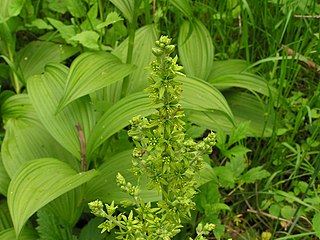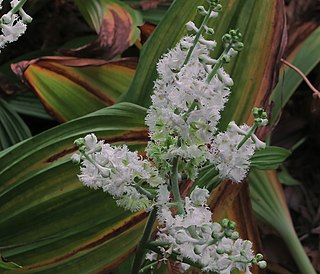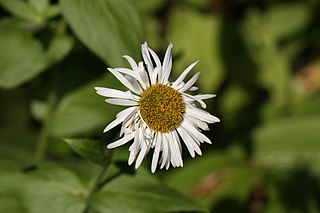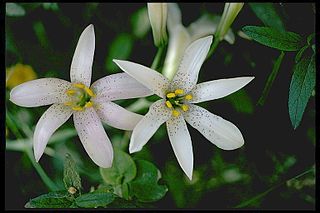
Veratrum viride, known as Indian poke, corn-lily, Indian hellebore, false hellebore, green false hellebore, or giant false-helleborine, is a species of Veratrum native to eastern and western North America. It is extremely toxic, and is considered a pest plant by farmers with livestock. The species has acquired a large number of other common names within its native range, including American false hellebore, American white hellebore, bear corn, big hellebore, corn lily, devil's bite, duck retten, itchweed, poor Annie, blue hellebore and tickleweed.

Veratrum is a genus of flowering plants in the family Melanthiaceae. It occurs in damp habitats across much of temperate and subarctic Europe, Asia, and North America.

Veratrum californicum is an extremely poisonous plant native to western North America, including the Sierra Nevada and Rocky Mountains, as far north as Washington and as far south as Durango; depending on latitude, it grows from near sea level to as high as 11,000 feet. It grows 1 to 2 meters tall, with an erect, unbranched, heavily leafy stem resembling a cornstalk. It prefers quite moist soil, and can cover large areas in dense stands near streams or in wet meadows. Many inch-wide flowers cluster along the often-branched top of the stout stem; they have 6 white tepals, a green center, 6 stamens, and a 3-branched pistil. The buds are tight green spheres. The heavily veined, bright green leaves can be more than a foot long.

Veratrum fimbriatum is an uncommon species of false hellebore, a type of plant closely related to the lily. Its common names are fringed false hellebore and fringed corn lily. It is endemic to California where it is a rare resident of the northern coastal scrub plant communities of Mendocino and Sonoma Counties. This flowering plant is a stout, hollow-stemmed perennial growing from a thick rhizome. The erect flowering plant bears several large, flat, green leaves near the base of the green stem. The large panicle inflorescence is packed with many distinctive, lacy-fringed flowers each up to a centimeter wide. The flower bud is club-shaped before it opens into a bloom of six frilly tepals, each of which bears two bright green or gold glands. The ovary and sepals extend straight outward as one thick stalk. The fruit is an oval-shaped capsule just under a centimeter long containing the seeds.

Allium haematochiton is a North American species of wild onion known by the common name redskin onion. It is native to northern Baja California, Sonora, and southern California as far north as Kern County. It grows on the slopes of the hills and mountains, such as those of the Peninsular Ranges, Transverse Ranges, and southern California Coast Ranges.

Allium dichlamydeum is a species of wild onion known by the common name coastal onion. It is endemic to California where it grows on sea cliffs and hills overlooking the ocean, from Santa Barbara County to Mendocino County.

Erigeron aliceae is a species of flowering plant in the family Asteraceae known by the common name Alice Eastwood's fleabane, or simply Alice's fleabane. It was named for American botanist Alice Eastwood, 1859 - 1953.

Erigeron bloomeri is a North American species of flowering plants in the family Asteraceae known by the common name scabland fleabane.
Erigeron cervinus is a North American species of flowering plant in the family Asteraceae known by the common names Siskiyou fleabane and Siskiyou daisy.

Erigeron glaucus is a species of flowering plant in the family Asteraceae known by the common name seaside fleabane, beach aster, or seaside daisy.
Enemion stipitatum is a species of flowering plant in the buttercup family known by the common name Siskiyou false rue anemone. It is native to northern California and southern Oregon where it grows in forest, woodland, and chaparral habitats in the local mountain ranges. This is a petite perennial herb producing one or more erect, unbranched stems to a maximum height no more than 15 centimeters. Leaves appear toward the top of each stem in arrays of several cloverlike leaves with three-lobed leaflets. The tiny solitary flowers each have five white petallike sepals only a few millimeters long. The center of the flower contains several thick white stamens topped with small yellow anthers and 3 to 5 styles.
Arnica spathulata is a rare North American species of flowering plant in the family Asteraceae, known by the common name Klamath arnica. It is native to the Klamath Mountains of northwestern California and southwestern Oregon. It grows in woodland habitat, almost exclusively on serpentine soils.

Calochortus persistens is a rare North American species of flowering plant in the lily family known by the common name Siskiyou mariposa lily. It is native to northern California and southern Oregon.

Prosartes hookeri is a North American species of flowering plants in the lily family known by the common names drops of gold and Hooker's fairy bells.

Erigeron petrophilus is a species of flowering plant in the family Asteraceae known by the common names rockloving erigeron or cliff fleabane. It is native to the mountain ranges of California from Siskiyou County south as far as San Luis Obispo County and El Dorado County. It also grows in southwestern Oregon.

Lilium bolanderi is a rare North American species of plants in the lily family, known by the common name Bolander's lily. It is native to northwestern California and southwestern Oregon.

Lilium rubescens is an uncommon species of lily known by the common names redwood lily and chaparral lily. It is native to northwestern California and southwestern Oregon, where it is known from the Coast Ranges from Lane County to Santa Cruz Counties.
Orthocarpus pachystachyus is a rare species of flowering plant in the broomrape family known by the common names Shasta owl's-clover and Shasta orthocarpus. It is endemic to central Siskiyou County, California, where it is so rarely seen it was thought to be extinct until 1996, when eight individuals were located. The plant grows in an isolated wilderness but since it apparently only occurs on one single hillside it is considered very vulnerable to extinction.
Packera macounii is a species of flowering plant in the aster family known by the common name Siskiyou Mountains ragwort. It is native to the west coast of North America from British Columbia to far northern California, where it grows in chaparral and mountain forests, often on serpentine soils.

Vancouveria chrysantha is a species of flowering plant in the barberry family known by the common names golden inside-out flower and Siskiyou inside-out flower.














